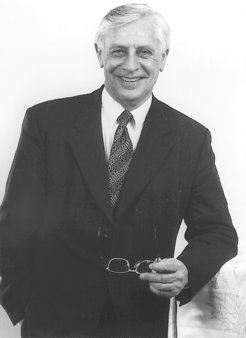Mountain in New Zealand Named after Former Director
A mountain in southern New Zealand now bears the name "Mount Axford" in honor of Sir Ian Axford, former director of the MPI for Aeronomy.
At 1720 meters, the highest and previously unnamed peak in New Zealand's Kepler Mountains has recently been given the name "Mount Axford." This decision has now been announced by the New Zealand Minister for Land Information, Damien O'Connor. He thus honors the New Zealand space researcher Professor Sir Ian Axford, who was director of the Max Planck Institute for Aeronomy (today: Max Planck Institute for Solar System Research) from 1974 to 2001 and contributed significantly to the institute's current international reputation. Mount Axford is now the third mountain in the Kepler Mountains to bear the name of a New Zealand space scientist.

The southwest of New Zealand’s South Island is home to Fiordland National Park. Within the National Park between Lake Te Anau and Lake Manapouri lie the Kepler Mountains covering an area of approximately 12000 hectares. They were named in honor of the German mathematician and astronomer Johannes Kepler. With their dense forests, rivers, lakes and rugged mountain peaks, the Kepler Mountains are a popular destination for hikers and nature lovers and are the habitat of endangered species of plants, birds and bats. Two of the highest peaks, Mount Pickering and Mount Tinsley, have borne the names of important New Zealand space explorers since 2010. They commemorate the space pioneer William Hayward Pickering, who was director of the American Jet Propulsion Laboratory (JPL) between 1954 and 1976 and led numerous space missions, and the cosmologist Beatrice Muriel Hill Tinsley, who from 1978 was the first woman to hold a chair in astronomy at the American Yale University and conducted research on the evolution of galaxies.
With Mount Axford, the highest mountain of the Kepler Mountains now also fits into this naming scheme. Renowned scientists from all over the world had declared their support to the New Zealand Geographic Board, which is responsible for assigning geographical place names. In their statements, they pointed out Sir Axford's decisive importance for space research. The final decision was made by Damien O'Connor, New Zealand's Minister for Land Information, on October 13 of this year.

With his decision, he pays tribute to a researcher who pioneered the study of the Earth's magnetosphere and heliosphere, the Sun's sphere of influence in space. Sir Axford's research provided fundamental insights into the structure of the magnetosphere, the origin of the solar wind and the acceleration of cosmic ray particles, among other things. As director of the Max Planck Institute for Aeronomy in Katlenburg-Lindau in Germany, the predecessor institute of today's Max Planck Institute for Solar System Research in Göttingen, he contributed significantly to the Giotto space mission to comet Halley and to the Ulysses and SOHO space probes. He also played a major role in the founding of the European Geophysical Society, of which he was president from 1990 to 1992, and the Asia Oceania Geosciences Society, which since 2018 awards the "Axford Medal" to distinguished scientists in Sir Axford's honor.
Ian Axford was born in New Zealand in 1933. After studying and earning a doctorate in engineering and mathematics in New Zealand and England, he first conducted research for two years on behalf of the Defense Research Board of Canada. This was followed by teaching and research activities at Cornell University (Ithaca, USA) and the University of California (San Diego, USA). In 1974 he was appointed Scientific Member of the Max Planck Society and Director of the Max Planck Institute of Aeronomy. With the exception of a three-year period from 1982 to 1985, when Sir Axford was Vice-Chancellor of Victoria University of Wellington (New Zealand), he retained this position until his retirement in 2001.
Sir Axford's many honors and awards include being named a Fellow of the Royal Society in London in 1986. In 1995 he was named New Zealander of the Year and a year later was knighted by the Queen of England for his services to science. The asteroid 5097 Axford bears his name in honor of Sir Axford.

